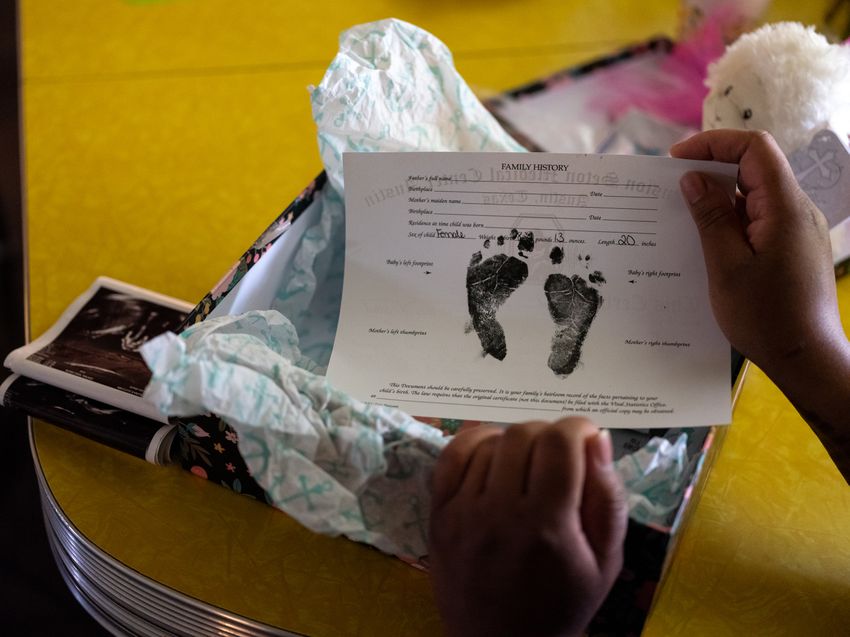Austin, TX
After an Austin employee gave birth to a stillborn baby, she was disqualified from parental leave. Now, city leaders want change.
/static.texastribune.org/media/files/ed2dbc4753779a104efa09c73238343a/Elena%20Stilborn%20IPL%20TT%2011.jpg)
Sign up for The Brief, The Texas Tribune’s daily newsletter that keeps readers up to speed on the most essential Texas news.
When Elena Andres held her stillborn daughter in her arms, she thought there was no way she could feel more devastated than she did at that moment.
The 15-hour labor wrecked her body, and she was drowning in grief. Rather than enjoying the early hours of her daughter’s life, she was filling out a mountain of paperwork and figuring out funeral home logistics.
When Andres notified her employer, Austin Public Health, that she’d be starting her planned maternity leave a little early, the response added insult to all that injury. She no longer qualified for the city’s eight-week paid parental leave, human resources told her.
“I felt so small, like they were saying my pregnancy didn’t count,” Andres said. “Like my daughter didn’t count.”
City of Austin employees can take eight weeks of paid parental leave after “the birth of a child or the placement of a child for adoption or foster care,” per the policy, and up to an additional four weeks unpaid under the federal Family and Medical Leave Act.

Elena Andres holds the urn she made for her daughter Maxine’s ashes.
Credit:
Ilana Panich-Linsman for The Texas Tribune
But as Andres learned over several painful days of negotiations, people who have stillbirths or lose a child soon after birth don’t qualify for the paid parental leave.
“Apparently our paid maternity leave is only for bonding with the newborn,” Andres said. “It’s not for recovering from birth. … The whole pregnancy, physically, whatever it does to the body of the person, they don’t care about.”
“It was like a kick in the face,” the 38-year-old South Austin mom said.
In a statement, a spokesperson for the city of Austin said federal FMLA guidelines for parental leave do not include stillbirths, which is why the city’s policy does not either.
Jenny LaCoste-Caputo, deputy communications director for the city of Austin, pointed to other leave options, including accrued sick and vacation time, three days of bereavement leave and a leave bank that employees donate to, which can be accessed only once all accrued leave is exhausted.
“City of Austin leadership will ensure any city employee experiencing such a devastating loss receives the support and time they need,” LaCoste-Caputo said. “We care for and value our staff members and are continuously looking for ways to provide needed support and will update policies to do so when those needs become evident.”
The need is evident now, according to several members of the City Council, who say they will be pushing for changes to the policy.
“There is no sensible reason why the City of Austin, who has posed itself as a family-friendly workplace, would hesitate to uphold the strongest parental leave program for our employees,” council member Vanessa Fuentes said in a statement. “I stand with the new parents who have undergone horrific loss and urge they be provided the full eight weeks of paid parental leave.”
Andres cobbled together vacation and sick time, as well as short-term disability coverage, to take six weeks off after getting a doctor’s note to qualify for medical leave under FMLA.
She was set to return to work next week. After The Texas Tribune asked city leadership about the policy, human resources offered her an additional four weeks of paid leave, which she plans to use to deal with her ongoing physical and mental distress. She’s still experiencing pelvic pain and hasn’t yet been able to find a counselor who takes her insurance. And she’s still dealing with the logistics from her daughter’s passing.
Before the city offered additional time off, Andres was preparing to return to work before she even got her daughter’s ashes back.
“It’s cruel. It’s absurd. And it’s unnecessary,” she said.
Preparing for paid leave
When Andres got hired by the city of Austin six years ago, she thought she was upgrading. She’d been working for the state of Texas, which had more opportunity for professional growth, but Austin offered slightly better pay, better benefits and more progressive policies.
At the time, the state didn’t offer any paid parental leave. (Earlier this year, legislators voted to offer six weeks paid parental leave to all state employees.)
Austin was the first city in Texas to adopt a parental leave program in 2013, and this year increased it to eight weeks of paid leave. By October 2024, all city employees will get 12 weeks paid parental leave.
Andres ran into no issues with her paid parental leave when she had her son more than two years ago. So when she found out she was pregnant again last year, she followed the same process to notify her superiors and human resources.
Ahead of her due date in late May, she did all the baby prep — decorating the nursery, picking out a name — and a lot of work prep. Andres works in contract compliance, so she was conscientious about making sure her department wouldn’t miss any key deadlines.
“I went out of my way to make sure that me being gone was not going to be a burden on my co-workers, on the process, on our policies,” Andres said. “If I had to hand it off, it was a neat little package — people will just have to pick up where I left off.”
Her pregnancy was mostly uneventful. But then, three weeks before her due date, she and her husband both developed food poisoning symptoms. She was throwing up so much she eventually went to the emergency room, where they gave her IV fluids and checked on the baby.
“She was doing better than I was,” Andres said, so once she could keep food down, they sent her home.
But the next day, the baby stopped moving. By the time Andres and her husband returned to the hospital, “she was already gone,” Andres said.
The doctors induced Andres, and she spent 15 hours delivering a full-term, 8-pound, 13-ounce baby without a heartbeat. They named her Maxine.
Haggling with HR
Andres got home from the hospital on Sunday, and on Monday, logged on to her work computer to tidy things up in preparation for her maternity leave to start the next day. But that’s when she learned she no longer qualified for paid parental leave.
“There I was, trying to wrap up my work so my leave wasn’t a burden on my co-workers, or so I didn’t get us in trouble for reports being late,” she said. “I feel so stupid for even trying.”
In an email exchange reviewed by The Texas Tribune, Austin Public Health’s human resources department told Andres she could get a doctor’s note to take time under FMLA, which is unpaid, and use vacation and sick time to cover her salary.

Flowers on Elena Andres’ kitchen table that she bought to try and cheer herself up after losing her daughter.
Credit:
Ilana Panich-Linsman for The Texas Tribune
Andres pushed back, trying to clarify why the paid parental leave policy wouldn’t extend to stillbirths. She couldn’t believe she had to haggle with human resources in the immediate aftermath of a tragedy, but she also felt like she wasn’t getting a straight answer.
At one point, the HR person said they were certain of the policy because the department ran into a similar issue last year, after an employee’s child died soon after birth. That employee also didn’t qualify for paid parental leave, according to the email.
“I can’t believe, then, no one thought to say, this should be changed,” Andres said. “It’s something that wouldn’t hurt them at all, but hurt me a whole bunch … and to learn it happened to someone else is so painful.”
Ryan Alter agreed. Alter, an Austin City Council member, said he was “disappointed” this wasn’t elevated up the chain the first time it happened.
“Whenever that was, last year, or I have to imagine it came up before that … we really should have figured out a way to make this right,” Alter said. “There’s always a way to do right by employees, and I’m disappointed we didn’t get it right this time.”
Alter said he plans to push the city to widen access to paid parental leave, as well as expand child care benefits.
In a statement, Austin Mayor Pro Tem Paige Ellis said the city should stand with Andres and other parents experiencing similar tragedies.
“Paid parental leave not only allows for bonding with the baby, it also supports women’s physical health,” Ellis said. “Beyond her physical health, she will need time to grieve, on top of the heart-rending logistical and paperwork nightmare that accompanies a stillbirth.”
Austin Mayor Kirk Watson echoed that call, saying he was committed to working with the city manager and the council to “explore how we can amend our policies so that we are helping our employees to heal, not adding to their profound sadness.”
There’s been a growing push to include pregnancy loss in parental leave policies, with some private companies allowing employees to take time off after miscarriages. In 2021, Washington, D.C., passed legislation that gives 10 days paid bereavement leave after a stillbirth or the death of a child under the age of 21.
The United States is one of just six countries in the world without a national paid parental leave program, and Texas does not require employers to offer any parental leave benefits. Advocates say expanding paid parental leave is an underutilized tool to help address Texas’ increasing maternal mortality rates, especially among Black women.
“Paid parental leave gives folks access to the most precious resource that we have, which is time,” said Alise Powell, a senior policy analyst with the National Birth Equity Collaborative. “Time to heal, to bond, to adjust to this new normal, and to figure things out and pivot if plans that you’ve made … ended up being different.”

Andres holds a box given to her by the hospital after she delivered her stillborn daughter.
Credit:
Ilana Panich-Linsman for The Texas Tribune
Powell said excluding pregnancy loss from these policies only excludes people who are facing extreme grief, as well as the exact same physical complications as someone who delivered a live baby.
Andres was nowhere near ready to go back to work next week. She’s still mired in grief and dealing with physical pain from the delivery. The additional month off will help, but it doesn’t make up for what the city put her through in the immediate aftermath of this tragedy, she said. And since she had to burn through her vacation and sick days, she has no leave saved up if she or her 2-year-old needs her to take time off of work.
She’s used most of her time off to do exactly what the paid leave was meant for — bonding with her child. It looks different than she imagined, but every painful task, from requesting her death certificate to handcrafting a tiny urn, was an act of love that bonded her more closely with the daughter she won’t get to raise.
“I had a baby. There was a physical child,” she said. “It just negates the whole thing. I really thought this city was different.”

Andres holds a dress she had bought for her daughter Maxine, who was stillborn.
Credit:
Ilana Panich-Linsman for The Texas Tribune
Go behind the headlines with newly announced speakers at the 2023 Texas Tribune Festival, in downtown Austin from Sept. 21-23. Join them to get their take on what’s next for Texas and the nation.

Austin, TX
The Ultimate Guide To Moving To Austin, TX

Moving to Austin, TX, is an exciting adventure, offering a blend of urban charm and scenic landscapes. Known as the “Live Music Capital of the World,” Austin brings together unique culture, a booming tech industry, outdoor recreational opportunities, and a vibrant nightlife. Whether you’re drawn by career prospects or Austin’s renowned lifestyle, this guide covers everything you need to know about relocating to this Texas gem.
Why Move to Austin, TX?
Austin’s population has surged in recent years as people flock here for its livability. This city appeals to diverse groups, from young professionals and families to retirees.
You’ll enjoy Austin’s thriving job market, especially if you work in tech, healthcare, or the creative industries. The friendly Texan culture and favorable weather are also major draws for those considering moving to Austin, TX.
Austin’s Neighborhoods
Austin’s neighborhoods are as varied as its residents. Here are some standout areas to explore:
- Downtown Austin.
- South Congress (SoCo)
- Westlake Hills
- Hyde Park
Cost of Living in Austin
While Austin’s cost of living is higher than the national average, it remains more affordable than many major cities. Here’s a breakdown of key expenses:
- Housing: Rental prices vary widely depending on the neighborhood. In 2024, the average rent for a one-bedroom apartment is around $1,600 to $2,000 monthly. Purchasing a home is also on the pricier side, with median home prices nearing $500,000.
- Utilities: Austin’s utility costs are about average compared to other U.S. cities. Expect to pay around $150–$200 monthly for essentials like electricity and water.
- Groceries and Dining: Dining out in Austin is affordable, with many options ranging from food trucks to fine dining. Groceries cost slightly more than the national average but won’t break the bank.
Job Market in Austin
Moving to Austin, TX, offers fantastic opportunities if you’re looking to grow your career. Known as “Silicon Hills,” Austin’s tech scene is thriving, attracting giants like Apple, Google, and Tesla. The city also boasts a strong job market in healthcare, education, and government sectors. Startups and creative industries are also booming, making Austin a haven for entrepreneurs and artists alike.
Places to Visit in Austin
Outdoor enthusiasts will love Austin’s proximity to natural beauty. From hiking trails and rivers to parks, there’s something for everyone:
- Lady Bird Lake: Perfect for kayaking, paddleboarding, and scenic hikes along the lake’s 10-mile trail.
- Zilker Park: This expansive green space hosts music festivals and events throughout the year and offers a place to picnic, play, and relax.
- Barton Springs Pool: A popular, spring-fed pool that remains cool even in the hottest months, Barton Springs is a local favorite for swimming and sunbathing.
- McKinney Falls State Park: Just a short drive from downtown, this park features picturesque waterfalls, camping, and miles of trails.
Entertainment and Culture in Austin
Austin is renowned for its live music scene, with genres ranging from country and blues to rock and jazz. For music lovers, The Continental Club, Antone’s, and the annual Austin City Limits (ACL) Music Festival are must-visit spots. The city’s art scene is also vibrant, with museums, galleries, and theaters adding to its cultural fabric. You’ll also find diverse dining options, from Tex-Mex and BBQ to global cuisine, showcasing Austin’s culinary diversity.
Things to Do in Austin
Austin hosts a variety of festivals and events throughout the year, including:
- South by Southwest (SXSW): This world-famous music, film, and tech festival attracts visitors globally and is a defining Austin experience.
- Austin Film Festival: Celebrating the art of screenwriting, this festival is a significant event for film buffs and aspiring writers.
- Austin Food + Wine Festival: Held each spring, this festival highlights Austin’s culinary talent and offers tastings, chef demos, and more.
- Trail of Lights: This annual holiday event lights up Zilker Park and is a festive experience for all ages.
Moving to Austin
If you’re planning on moving to Austin, TX, preparation is essential. Here are some practical tips to ease your transition:
- Timing Your Move: Avoid moving during the height of summer if possible, as the heat can make the process challenging.
- Registering Your Vehicle: Texas requires newcomers to register their vehicles and obtain a Texas driver’s license within 30 days of establishing residency.
- Choosing a Moving Company: Research Austin movers to ensure you have reliable professionals to assist with your move.
Preparing for Texas Culture
Texans are known for their warmth, friendliness, and pride in their state. In Austin, you’ll find an inclusive, progressive atmosphere mixed with Texas traditions. Barbecue is a must-try, and you’ll quickly find yourself saying “y’all” as you embrace the local culture. Football is also a big deal in Austin, with the University of Texas Longhorns drawing massive crowds each fall.
Getting Settled in Austin
Once you’ve settled in, take the time to explore Austin’s community resources. Many neighborhoods have community centers and organizations that offer classes, events, and volunteer opportunities. Additionally, you’ll find ample resources for newcomers through Austin’s Chamber of Commerce.
Making Friends and Networking
Austin is a welcoming city, and there are plenty of ways to build connections. Joining local groups, volunteering, or attending community events can help you meet people with similar interests. Austin’s social scene thrives in coffee shops, breweries, and co-working spaces, making networking easy and enjoyable.
Is Austin, Texas, a Good Place to Live?
Moving to Austin, TX, offers a unique lifestyle filled with opportunities for personal and professional growth. From its creative culture to its tech-driven economy, Austin provides the perfect mix of modern city life and natural beauty. Whether you’re single, starting a family, or exploring a new chapter, Austin’s vibrant community and friendly atmosphere make it a top relocation choice.
As you plan your move, consider reaching out to Austin movers for professional assistance. They can help streamline the moving process, so you can focus on enjoying everything this fantastic city has to offer.
Austin, TX
I'm a Jewish parent and biblical scholar in Houston — I'm enraged that Texas is adopting this biblically illiterate new curriculum


The Texas state flag flies in Austin, TX. Photo by Getty Images
I love the Bible. That’s why I’ve chosen to devote my career to reading and dissecting it, finding new ways to parse its texts and meanings, and teaching about it to classrooms full of undergraduates at a state university in Texas. I believe that learning about the content of the Bible is important for understanding not only religion, but also world history, politics, art and literature.
But not like this.
The Bluebonnet curriculum about to become part of classroom instruction in some Texas public schools is a travesty. Friday, the Texas State Board of Education voted 8-7 to accept a school curriculum that smuggles Christian religious instruction into public schools. The curriculum is voluntary, but school districts that adopt it will receive financial incentives.
The creators of the curriculum have defended its biblical content on the grounds that the Bible is a foundational document of our civilization, so students must understand it to be well-educated citizens. But if an understanding of the Bible — and not indoctrination with a Protestant Christian view of the Bible — is the main goal here, then why does the curriculum show so many signs of biblical illiteracy?
For example, in a kindergarten unit on kings and queens, students learn that King Solomon built the Temple in Jerusalem because “he wanted his people to have a place to gather, pray, and sing songs to God.” The Hebrew Bible does not describe most of these activities taking place at the Temple or its predecessor, the Tabernacle. What it does describe is lots and lots of animal sacrifice. The lesson ignores the actual biblical material in favor of grafting onto biblical Israel what Protestant Christians do in churches today — what a coincidence.
I also note that biblical scholars have yet to find evidence from outside the Bible of Solomon doing the things the Bible credits him with, or even evidence of his existence. He is an important figure for Jewish and Christian religious believers, but he cannot be treated as historical. In the sections of the kings and queens unit on King Midas and Cinderella, the curriculum prompts teachers to ask students which aspects of the stories could happen and which are “magic or fantasy.” There is no such prompt in the King Solomon lesson. He is treated as a historical figure and the story of his God-given wisdom is treated as fact. It is not.
In another example of biblical illiteracy, the curriculum introduces the biblical Queen Esther to second graders in a unit on “fighting for a cause.” Again, this story is presented as historical, though there is little in the story and nothing outside the Bible to indicate its historicity. More egregiously, the curriculum writes God and faith into a biblical book that famously mentions neither. Esther’s fast is given religious motives, while the text says nothing of the sort. Esther is characterized as fighting for the right of the Jews to practice their own religion, with the curriculum drawing a parallel between this story and historical tales of people seeking religious freedom in the United States.
Again, religious belief is not mentioned in Esther. What is at stake is the survival of the Jews as a people. This is nothing less than a Christian colonization of the story of Esther to make it look more like Protestant narratives of freedom of worship. (It is also more than a little ironic to stress freedom to worship for religious minorities when you are in the process of imposing your religion on those religious minorities.)
The fighting for a cause unit lists as an objective: “Describe the similarities among the methods of nonviolence used by Queen Esther” and the other figures studied. This characterization of Esther’s story as nonviolent would be hilarious if it weren’t part of a pernicious and unsubtle effort to sneak Christian religious instruction into Texas schools. Did the authors of this curriculum read a version of Esther that was somehow missing the final chapters, where the Jews slaughter those who would have killed them? Where Esther asks the king for permission for a second day of killing? Where the 10 sons of Haman are killed? I can only surmise that this is part of the evangelical tendency to sanitize the Bible so it falls more in line with contemporary sensibilities, what my biblical studies colleague Jill Hicks-Keeton calls “making the Bible benevolent.”
While I am a biblical scholar by training, I also teach Jewish Studies courses and direct my university’s program in Jewish Studies. I have observed a tendency among my students, many of whom were educated in Texas public schools, to seriously misunderstand Jews and Judaism. I blame this in part on the misguided concept of the “Judeo-Christian tradition,” a phrase that appears in the Texas education standards more than once. The idea that there is a real thing called “Judeo-Christian” obscures the major differences between these two religions, and between Jewish and Christian interpretations of the Hebrew Bible.
Many of my students arrive at university believing Judaism and Christianity are essentially the same religion. Some do not understand that Jesus does not figure into Judaism in any way. Those who do know that Jews do not believe Jesus was the messiah or a prophet often assume that Judaism is just Christianity minus Jesus, or perhaps the Old Testament plus time. These students have an especially hard time understanding that Jews and Christians read the Tanakh and the Old Testament, respectively, in radically different ways.
I worry that, when lessons like the ones I point to above from the Bluebonnet curriculum make their way into Texas classrooms, the problems of biblical and religious illiteracy will worsen among my students. By learning readings of the Hebrew Bible that are indefensible from a scholarly perspective and only make sense if your goal is Christian indoctrination, how much more will they struggle to understand that people can read the Bible in more than one way, and that Judaism is not a flavor of Christianity?
I am indignant about Bluebonnet not only as a scholar and a teacher, but also as a Jewish parent. While my children currently attend a Jewish school, when they finish elementary school, they will likely move to public school. If Houston public schools adopt the Bluebonnet curriculum, my children will be attending the upper grades alongside kids who have learned incorrect, misleading, exclusively Christian-source information about the sacred texts of our religion.
If students are taught in kindergarten that King Solomon built a Temple that functioned much like a contemporary Protestant church, or in second grade that Queen Esther was a nonviolent activist for religious freedom, they do not have to do any hard work to understand the Hebrew Bible in its ancient context, not to mention its contemporary Jewish context. The Bluebonnet curriculum takes a rich collection of texts that are sacred for multiple religions and reads them in ways that are inaccurate, misleading and offensive — and that will produce biblically illiterate Texans.

I hope you appreciated this article. Before you go, I’d like to ask you to please support the Forward’s award-winning, nonprofit journalism during this critical time.
We’ve set a goal to raise $260,000 by December 31. That’s an ambitious goal, but one that will give us the resources we need to invest in the high quality news, opinion, analysis and cultural coverage that isn’t available anywhere else.
If you feel inspired to make an impact, now is the time to give something back. Join us as a member at your most generous level.
— Rachel Fishman Feddersen, Publisher and CEO
With your support, we’ll be ready for whatever 2025 brings.
Austin, TX
AP Poll Top 25 Rankings: Where Are Texas Longhorns?

AUSTIN — The No. 3 Texas Longhorns secured their second straight 10-win season Saturday with a 31-14 victory over the Kentucky Wildcats on Senior Day at DKR.
Texas stayed steady on a day where the rest of the SEC experienced chaos, as three ranked teams lost to unranked opponents on the road. The Longhorns entered as the No. 3 team in the College Football Playoff rankings and the AP Poll, but their win wasn’t enough to move them ahead in the AP’s Week 13 release.
No. 1 Oregon, No. 2 Ohio State, No. 3 Texas and No. 4 Penn State all remained idle in the AP Poll. The Ducks were on a bye while the other three teams picked up wins. The Longhorns are one of eight SEC teams in the AP Top 25, joining No. 6 Georgia, No. 7 Tennessee, No. 13 Alabama, No. 15 Ole Miss, No. 16 South Carolina, No. 20 Texas A&M and No. 24 Missouri.
Texas has now been No. 3 in the AP Poll for three straight weeks. The Longhorns have fallen to as low as No. 6 and have been as high as No. 1.
Now, Texas has arrived to one of the most anticipated weeks in the state’s college football history, as the Longhorns will travel to College Station for Saturday’s meeting with the Texas A&M Aggies. The renewed rivalry will kick off from Kyle Field at 6:30 p.m. CT and will be broadcast on ABC.
Join the Community:
Subscribe to our YouTube Page HERE
You can follow us for future coverage by subscribing to our newsletter here. Also, be sure to like us on Facebook @LonghornsCountryOnSI & follow us on Twitter at @LonghornsSI
Other Texas Longhorns News:
MORE: Here Is What The College Football Playoff Bracket Looks Like After Nov. 19 Rankings
MORE: Texas Longhorns Announce Home and Home Matchup vs. Notre Dame Fighting Irish
MORE: Texas A&M Aggies Coach Slips Up In Press Conference When Asked About Texas Longhorns
MORE: Brent Venables Blasting 5-Star Commit For Visiting Texas Longhorns? ‘Not Committed!’
MORE: Texas Longhorns Remain at No. 3 in Latest College Football Playoff Rankings
-

 Business1 week ago
Business1 week agoColumn: Molly White's message for journalists going freelance — be ready for the pitfalls
-

 Science6 days ago
Science6 days agoTrump nominates Dr. Oz to head Medicare and Medicaid and help take on 'illness industrial complex'
-

 Politics1 week ago
Politics1 week agoTrump taps FCC member Brendan Carr to lead agency: 'Warrior for Free Speech'
-
/cdn.vox-cdn.com/uploads/chorus_asset/file/25739950/247386_Elon_Musk_Open_AI_CVirginia.jpg)
/cdn.vox-cdn.com/uploads/chorus_asset/file/25739950/247386_Elon_Musk_Open_AI_CVirginia.jpg) Technology1 week ago
Technology1 week agoInside Elon Musk’s messy breakup with OpenAI
-

 Lifestyle1 week ago
Lifestyle1 week agoSome in the U.S. farm industry are alarmed by Trump's embrace of RFK Jr. and tariffs
-

 World1 week ago
World1 week agoProtesters in Slovakia rally against Robert Fico’s populist government
-

 Health3 days ago
Health3 days agoHoliday gatherings can lead to stress eating: Try these 5 tips to control it
-

 News1 week ago
News1 week agoThey disagree about a lot, but these singers figure out how to stay in harmony

:focal(0x0:3000x2000)/static.texastribune.org/media/files/ab295039087efb8f48e708c4cde2a51d/Afton%20Crypto%20Farm%20TrT%20TT%2005.jpg)

















